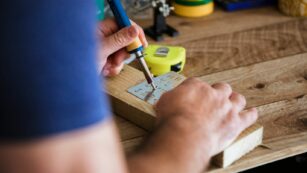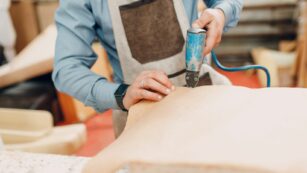In a world where sustainability is more crucial than ever, upcycling furniture projects have emerged as a creative and eco-friendly solution. They transform old, forgotten pieces into stunning, functional art that breathes new life into any space. With a little imagination and effort, anyone can turn discarded furniture into something unique and valuable.
As more people embrace the charm of upcycled furniture, these projects continue to gain popularity. They offer a rewarding experience that combines craftsmanship with sustainability, proving that one person’s trash can truly become another’s treasure. Whether you’re a seasoned DIY enthusiast or a beginner, upcycling offers a fulfilling way to refresh your home while caring for the planet.
Upcycling Furniture Projects
 Upcycling furniture projects offer diverse options for creatively repurposing pieces. Chairs, tables, and dressers, for example, can all be transformed into innovative designs. These projects not only enhance aesthetic appeal but also improve functionality, adding a sense of uniqueness to each item.
Upcycling furniture projects offer diverse options for creatively repurposing pieces. Chairs, tables, and dressers, for example, can all be transformed into innovative designs. These projects not only enhance aesthetic appeal but also improve functionality, adding a sense of uniqueness to each item.
-
Painted Chairs: Transform old chairs with vibrant color schemes. Using chalk paint simplifies the process and provides a matte finish.
-
Refinished Tables: Sanding and staining give wooden tables a renewed look. Sealants offer added protection.
-
Reupholstered Sofas: New fabric brings life to worn sofas. With a staple gun and some fabric glue, the transformation process is straightforward.
Tools and Materials
 Essential tools include sanders, paintbrushes, and power drills. Materials like paints, stains, and upholstery fabric enhance creativity. Purchasing quality supplies ensures durability and high-quality finishes.
Essential tools include sanders, paintbrushes, and power drills. Materials like paints, stains, and upholstery fabric enhance creativity. Purchasing quality supplies ensures durability and high-quality finishes.
Upcycling reduces landfill waste and conserves resources. By choosing eco-friendly materials, such as non-toxic paints and reclaimed wood, the projects further align with sustainable practices. Demonstrating an eco-conscious mindset, these revisions contribute to environmental conservation.
Participants refine skills like carpentry and design through upcycling. This hands-on experience boosts confidence, encourages experimentation, and provides technical knowledge applicable to future projects. Engaging in such activities fosters personal growth and skill enrichment.
Benefits Of Upcycling Furniture Projects
Environmental Impact
Upcycling reduces waste by repurposing old furniture instead of discarding it. Fewer items end up in landfills, conserving resources and decreasing pollution. This process limits deforestation and reduces the demand for new materials, supporting a healthier planet. The environmental benefits compound as more people engage in upcycling.
Cost-Effectiveness
Upcycling saves money by reusing existing pieces rather than purchasing new. Individuals can make stylish, functional furniture on a budget by investing in minimal supplies. Even luxury looks become accessible through creative reuse, allowing for affordable personalization. Upcycling projects often require less financial investment compared to buying new furniture.
Creative Expression
Upcycling fosters creativity by encouraging individuals to redesign and reimagine furniture pieces. Each project becomes a unique artwork reflecting personal style, with limitless possibilities. Skills in painting, fabric selection, and design emerge as individuals experiment with patterns and textures. The process offers an opportunity to create distinctive statement pieces tailored to one’s taste.
Essential Tools And Materials For Upcycling
Upcycling furniture requires specific tools and materials to achieve professional results. Properly equipped individuals find the process more efficient and enjoyable.
Tools
-
 Sander: Essential for smoothing surfaces and removing old paint or finish.
Sander: Essential for smoothing surfaces and removing old paint or finish. -
Paintbrushes: Various sizes allow for precision and coverage in painting tasks.
-
Screwdrivers: Necessary for disassembling and reassembling furniture components.
-
Pliers: Useful for gripping, twisting, or cutting wires and small metal parts.
-
Measuring Tape: Ensures accurate dimensions for modifications and adjustments.
-
Eco-friendly Paints: Low in VOCs, offering a safer choice for the environment and health.
-
Sealers: Protects painted surfaces and enhances durability.
-
Fabric: New or repurposed for refreshing upholstery and cushions.
-
Wood Stains: Changes or enhances wood color while highlighting natural grain patterns.
-
Glue and Adhesives: Bonds materials securely for structural integrity.
When equipped with these tools and materials, individuals transform old furniture into functional art, merging creativity with sustainability. Each item contributes to a seamless upcycling project, resulting in aesthetically appealing creations.
Popular Upcycling Techniques
Painting And Refinishing
Painting and refinishing breathe new life into old furniture. Using chalk paint or other eco-friendly options, individuals can update a piece’s appearance, offering a fresh color and finish. Refinishing involves stripping old varnish or paint, sanding the surface, and applying a new finish for a polished look. Incorporating these techniques creates a renewed visual appeal while preserving the underlying structure.

